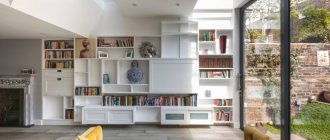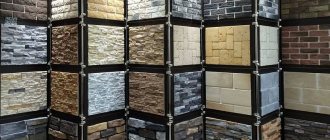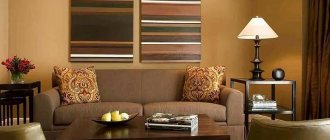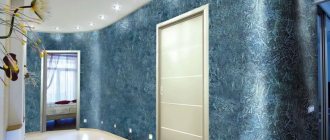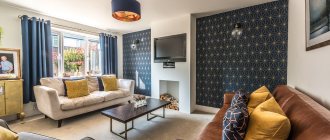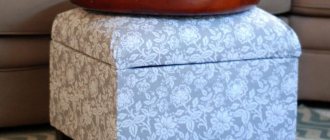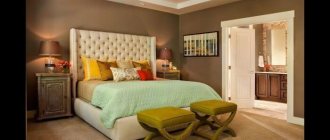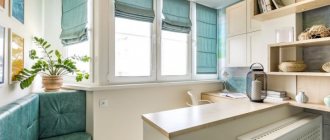A shelf door is one of the types of stationary doors known to us from the era of knights and castles. Behind them there was usually a secret passage through which one could escape unnoticed from the fortification or a secret room in which documents or treasures were kept.
In those days, there was no problem of small areas and space optimization. Now such a shelving door can be used not only for secrecy, but also for more rational placement of furniture, increasing useful space for storing and managing the design of your home.
If you decide to make your home unique and functional, then a secret door is an interesting solution. And here on the market of ideas you will be able to see not one proposal, but several. How exactly will your shelves move? What configuration?
The mobile rack has several types of movement:
— 1 hinged, with regular fittings; — 2 rotary — having a central axis; - 3 folding - divided into two parts, which fold and thereby open the passage. This option may be automatic. — 4 sliding – when the doors are on “rails” and work on the principle of a compartment.
We will consider all these possible implementations below in more detail and with photographs. But it’s also worth noting that the shelving is not the only type of secret door. What do you think of the idea of a door disguised as a mirror? Or maybe a picture?
Or maybe the door will be a staircase? Look at all the options for the secrets of transition to another, each of them will have from decorative to practical applications.
Door rack - not for mystery, but for convenience
Habitually opening doors can be divided into two categories: - An opening occupied by shelves; - bookcase with a secret door. In the latter case, this can serve as a partition in one large room - become a zone-determining factor, as in the next photo.
A door and a door that opens into another are fundamentally different in installation. If for the first option the depth of the useful surface is equal to the depth of the opening (wall thickness), which usually does not exceed 17 cm, then this is practically a decorative surface. When making calculations, keep in mind that the base of the average Russian book is 13 cm. But the lighter the stand, the safer and more reliable the mounting on ordinary hinges.
The cabinet can be more than 20 cm deep. Full of storage convenience and completely hiding secrets. It is not easy to open such an array, so its fastening can be vertical, like an axis to the top and bottom. Reinforcement around the perimeter is desirable for greater reliability.
You can use your imagination and not get hung up on them; it can be anything: a stand for storing wine or a shoe rack. Experiment!
How to make a secret door with your own hands
A secret door can be made to order in special companies that perform the work individually for a specific room. Here they will assemble and disguise the structure themselves. The price of such services for the individual production of invisible door panels can be very high. Then the question arises: is it possible to make a secret passage with your own hands?
The simplest solution is to purchase ready-made hidden interior doors for painting. They are made of metal, which ensures their strength and durability. The box is made of aluminum profile and is securely hidden in the wall. This design can be installed flush with the wall to finish it and make it invisible. The disadvantage of this solution will be a certain thickness of the canvas, which may differ significantly from the width of the wall. Therefore, it is only suitable for creating the effect of invisibility from the side of one of the separated rooms. The advantage of a purchased design is the presence of special hidden fittings.
The main condition for creating an invisible door is a hidden door frame. You can disguise it with plasterboard, without installing platbands. If you have minimal carpentry skills, you can convert it into an invisible one yourself. The least amount of work will have to be done when the door leaf of a conventional design, when closing, is flush with the door frame. In this case, it will be enough to replace the hinges with hidden ones and mount the canvas so that on one side it merges with the plane of the wall. There is no need to install platbands.
If the width of the box differs from the width of the canvas, then you will have to put in more effort to remake it. First you need to disassemble the entire structure, remove the beam that forms the box, and reduce its size using a plane. With some skills, this type of work can be done at home. Then the box is assembled in its place and the canvas is hung on it using hidden hinges.
It is more difficult to make a door yourself that is invisible from both sides. The thickness of the door leaf is usually not equal to the thickness of the wall, so the task arises of increasing its width. This is easier to do for a frame structure. You just need to disassemble it, redo the frame, adding new layers, and glue back the removed overlays. All that remains is to make recesses around the perimeter for the false strip.
A door that does not have a frame will have to be practically made from scratch. This work is already for craftsmen who have the necessary materials and equipment to produce a new canvas.
Folding door
A folding door is as stable as possible given its occupied space. Its doors bend outward - deep into the space, which makes it possible to occupy the entire opening without touching the side spaces outside it. This is maximum compactness and efficiency.
Such a door is mounted on rails at the top and bottom, which guarantee the stability of the structure during the operation of the opening and closing mechanism. At the same time, this process is as easy as possible, so even a child can handle it. And the most interesting thing is that it can be made automatic!
Features of hidden doors, design and materials of manufacture
A secret door is a special design that is difficult to see in the surrounding environment. Usually behind such doors they hide niches or full-fledged rooms that you don’t want to show to strangers.
Today, there are many ways and recommendations on how to make a secret door and fit it harmoniously into the interior.
Manufacturing materials:
- Tree. A door made of this material may look like a cabinet compartment, in which case no one will guess what is behind it.
- PVC. Such a door is equipped with double-glazed windows, or it is covered with a plastic panel. It is quite difficult to disguise such a product.
- Glass. Tempered glass coated with impact-resistant film is durable and not subject to mechanical stress. The coating can be almost anything - acrylic, mirror film, varnish or even wallpaper. The variety of coating options and the smoothness of the surface make the door almost invisible.
- Metal. It is durable, but such a door is difficult to paint or process in any way, and therefore camouflage is quite problematic.
Opening mechanisms:
- Swing door. The opening principle is the same as that of a regular door, so it is easy to implement. Such a product is practically invisible against the background of the wall; the presence of a passage is revealed only by the handle or noticeable outlines.
- Roto door. Expensive and unusual way. The door rotates like a vertical turnstile - there is a central hinge, relative to which the door leaf rotates around its axis. You don't need a handle to open the door, you just need to push it lightly and it will turn. For greater tightness, the canvas can be equipped with a magnetic lock.
- Pendulum door. It is based on a rotating mechanism, so the doors open both towards and away from you. The mechanism is hidden in canopies located above and below the door leaf. Also, if necessary, closers are installed in canopies, which is quite convenient, because in this case the doors close automatically. This is an average cost option, however, there is a small drawback, the door will not provide soundproofing.
- Sliding door. The design assumes the presence of hidden hinges and a pencil case mounted directly into the wall. The door slides into the pencil case, due to this, great space savings are achieved, because there is no need to leave space to open the door in the traditional way. The door opens and closes silently, and the door itself does not allow sound to pass through. It is possible to install an electric mechanism to move the door.
Sliding
Such cassette-type canvases, when opened, move parallel to the walls or into special niches built into them. This is a great option for small rooms where there is a lack of free space. When open, the door can be successfully disguised as a wall or completely hidden inside.
This hidden system for sliding doors is absolutely silent and provides excellent heat and sound insulation. They fit perfectly into any interior design. The most famous hidden system for sliding doors is called Magic by Sofia. The same company patented the Invisible and Penal mechanisms.
Folding
A couple of models are called folding - an accordion and a book. The first is great for loggias, kitchens, and balconies. The second fits perfectly into the design of bedrooms and living rooms, because it looks presentable. Installation of hidden doors of this type occurs with the help of a specialist.
Such a system also has disadvantages - low heat and sound insulation, but they are compensated by space savings and non-standard appearance. High-quality products are silent and safe (due to the absence of thresholds). The design can be one- or two-sided, symmetrical or asymmetrical.
Sliding
Sliding version of a secret door
There are several design options for sliding doors.
- If they are glass, they move more often along the outer surface of the wall; aluminum ones can fold like an accordion.
- But only the option that opens like a pencil case can be classified as invisible, when the canvas goes inside the wall, in which internal space is provided for this.
- True, in this case, even if the door is finished in the same way as the wall, the opening remains noticeable, since the canvas is not flush with it.
- The advantage of this design is that no space is required to open the door, and the wall can be filled with furniture right up to the opening.
- The only condition: that the wall itself has the required length - therefore, for example, it will not be possible to install such a door at the end of a narrow corridor.
Swing
In such a partition, even the gap in the door narthex will be invisible
This is the most common option because it is the cheapest. In fact, this is an ordinary swing door, only thanks to its installation on hidden hinges, it is less accentuated on the wall.
Although, of course, the contour line of the opening will still be visible if it is not hidden, as in this photo, due to the finishing.
Rotary
Roto doors are often made of glass
In this case, the door leaf is not attached to hidden hinges, but is fixed in the opening - to the upper and lower horizontal surfaces. Such a door opens by turning under the influence of a push from itself, so it does not even need a handle.
The canvas is fixed in the opening using a magnetic latch. This type of door fits the concept of “invisibility” best. It opens silently in both directions, and when opened, takes up half the space than a traditional swing door would require. This is its main advantage.
Pendulum
Interior with invisible swing door
In this case, we are also dealing with a rotating mechanism. It is very similar to the previous version, but it can not only rotate 90 degrees to let a person through, but can completely rotate around its own axis.
The canopies that hold the canvas simultaneously act as a spring mechanism and/or a closer. Externally, a swing door cannot be distinguished from a rotary door. Their advantage is that they can accommodate a large flow of people, which is why such structures are often installed in public places.
Mirror door
A mirror door is another option for a secret entrance. But if they were needed to store things (most often books), then the mirror, although a functional thing, will serve more for design than economy. Why is this necessary? Have you noticed that the door, like a massive, tall element, visually eats up the space of the room? A mirror, on the contrary, can expand it, adding volume and air.
It is these considerations that can help replace the door with a mirror. True, for the stability of such a door you will need a threshold of 15 centimeters, as well as a strong frame. It is advisable that the door be narrow: the smaller the mirror, the longer it will last.
What is this?
Hidden installation of doors is an ultra-modern way of designing entrances and exits using hidden hinges.
Thanks to the inner frame, the door will be invisible and the feeling of a blank, uniform wall will be created. Today, secret doors serve slightly different functions than before. If, since the Middle Ages, invisible entrances hid behind them secret rooms into which strangers were not supposed to enter, today the main purpose of installing a hidden door is to dissolve the canvas itself into the wall, thereby achieving a minimalist design and visually expanding the space.
The most advantageous place for hidden doors in a house is a corridor or hallway with many entrances and exits. When replacing standard doorways with platbands with hidden ones, you will get a spacious room with neat walls without unnecessary accents.
Hidden doors in the living room perform the same functions as in the hallway. But in the bedroom, using a secret door, you can hide a dressing room, which guests should not enter. Storerooms (for example, in the kitchen), offices and other personal spaces can also be hidden.
Door staircase
This option is relevant for a home or country house. With it you can effectively connect two spaces, bypassing additional corridors and doors. Not only does this make it easier to move around your home, but it also adds intrigue to your walled home.
It will also be interesting: Arranging a greenhouse inside: layout tricks
A staircase door can have a different mechanism: from automatic (a mechanism similar to the one that opens garage doors) to mechanical like a swing.
Types of finished structures
Hidden doors differ in the material they are made of, but it is more advisable to use MDF or chipboard to create them. These slabs are inexpensive and easy to decorate. The main feature of the design is an invisible box, which is puttied simultaneously with the wall and covered with the same finishing material. As a result, the opening becomes invisible. The door leaf itself is finished in the same way. After installing it, only a rectangular outline remains on the wall.
There are one-way (hidden in only one room) and two-way doors. The second option is used extremely rarely. It involves installing a canvas with a thickness equal to the parameters of the wall.
According to the system of opening mechanisms, invisible door leaves are divided into:
- Swing. Hidden door hinges suspended on special frames and panels mounted inside. They imply the presence of a handle or lock.
- Roto doors. They are a structure that rotates around its axis thanks to a hinge mechanism. To open such a mechanism, you just need to push the blade from any side, which eliminates the use of handles. To ensure tightness, rotary systems are equipped with magnetic locks.
- Pendulum. They have a similar design to the previous version, but they are fastened along the edge of the box to special canopies. They allow the canvas to open in both directions after a push. When installing hidden doors, it is recommended to equip them with canopies with closers that will automatically close the passage.
- The sliding mechanism allows you to remove the door to the side by sliding it inside the pencil case located in the wall. This option is advisable to use in small rooms, so as not to leave free space for moving the canvas.
Wardrobe – door to pantry
If your kitchen is adjacent to a pantry, and the wall with a door is a convenient place to place kitchen units, a reasonable and organic option would be to design the door as a kitchen one. This technique will help make your kitchen harmonious; an additional one will increase the usable storage area and introduce an element of surprise for the uninitiated.
Using curtains
You can cheaply disguise a secret room using curtains. In comparison, the cabinet is a more expensive option. For this, regular fabric canvases or their draped version are suitable.
In the process of masking with your own hands, you should use a cornice, which is attached to the ceiling using brackets. You can hide a small dressing room behind the curtains or make the closet invisible.
However, if the owner of the house wants to hide something dangerous, then this can only be done behind a door with a lock.
There are places in every person's house where he would not like to let his guests. The premises can have different purposes: storage room, personal office, dressing room. You can avoid unplanned entry one hundred percent if you carefully disguise the door. Only the owners of the house will know about this entrance. You can choose any of the options and bring it to life in your interior.
A secret door is a convenient feature of the interior. It can be disguised behind a closet, curtain, picture or mirror. You will be able to have a room to which only you will have access.
Door - painting
A passage covered by a picture is a purely decorative device used to impress or confuse a random (or not) guest. This technique is interesting for public places: bars, clubs, billiard rooms and others. It creates an atmosphere and allows you to control the visitor’s desires, because the secret draws you to itself!
Invisible wardrobes - assistants to designers and housewives
An invisible wardrobe (also known as a built-in wardrobe) is a very popular design solution nowadays. This is a great opportunity to get rid of bulky and awkward pieces of furniture (cabinets, sideboards, chests of drawers) that take up space in the apartment. The built-in wardrobe can be called a symbol of the modern design style called minimalism.
Author of the article: Button
Door-panel
This is an ordinary swing door, but its design makes it possible to get lost in the wall. And this again leads us to an increase in space, the rejection of unnecessary elements. Perhaps behind such doors you will be disturbed less.
Tips for creating a secret door
If you don’t want to contact special companies for the production of custom-made secret doors, then when working independently you should adhere to the following tips:
- it is mandatory to install or replace regular hinges with invisible (secret) ones;
- selection and installation of special invisible fittings;
- if there is a cavity in the wall, the best solution would be to install a sliding structure;
- a passage disguised as a wall should be made flush with its plane;
- the box for the secret passage must be hidden in the wall or disguised;
- It is allowed to use a rotating mechanism for hidden passage.
If you follow the rules for installing secret interior doors, it’s not at all difficult to do it yourself. This design will help hide from prying eyes everything the owners want - from the pantry to the safe.
Door under wallpaper
This option is less hidden than the previous ones, but it is very interesting from a design point of view: it is possible to expand the space, but there is no feeling of disorientation in the room. You can enjoy the beauty of wallpaper or even photo wallpaper without interruption.
Advantages and disadvantages
Advantages of hidden doors in the interior:
- Stealth. This gives more options in wall decoration and allows you to hide insignificant spaces, such as storage rooms.
- Variability of finishing. If ready-made factory doors from the manufacturer have a certain color that is not easy to match to the walls, then custom hidden doors can be painted in any shade or even covered with wallpaper.
- Compactness. The inner box, hidden hinges and the absence of platbands allow the installation of a hidden door even in narrow passages.
- Saving. Moldings are often more expensive than door panels, but in the case of hidden doors you won’t have to buy them.
- Large selection of sizes. The height and width are practically unlimited - you can order a model with standard dimensions or a non-standard floor-to-ceiling canvas. Of course, its cost will be higher, but you will be able to implement any design solution.
Disadvantages of invisible openings:
- High price. Although interior doors do not require a frame or trim, the door leaf itself can cost a pretty penny. The most budget option is the standard size (70*200, 80*200) without finishing.
- Complicated installation. Since hidden interior doors in the interior still remain a curiosity, not every master is ready to take on such work and do it efficiently. The average cost starts from 3000 and reaches 5000-6000 per unit.
- Lots of nuances. If conventional models can be installed during decorative finishing, then hidden solutions are installed at the stage of rough work.
- Limited styles. Hidden canvases look ultra-modern, therefore they are suitable mainly for current styles: modern, minimalism, loft. At the same time, it is almost impossible to fit them into classics, Provence or Baroque.
- One-sided beauty. Aesthetic fit and invisibility in standard openings will be only on one side: on the “wrong side” there will be a recess that will be clearly visible even when decorating the space with the same materials. This is due to the small thickness of the door, which makes hidden installation possible.
The photo shows a hidden door in the interior of the hall
Door to be painted
The recently popular coloristic room design, based on bright colors that are distributed throughout the room in measured zones, does not need to stop at a banal door when it can be made part of the action. However, this type of design requires a preliminary design.
Our daily life consists of many small things, be it books, boxes of postcards
or souvenirs and interior accessories: vases, candles, etc. All this is our manifestation, and if we change, then our favorite objects undergo changes: they disappear from a prominent place, new ones appear, or are simply placed in different places.
Shelving satisfies the need to change. Changing the design means creating changes in your life.
Furniture has become irreplaceable in the design of small apartments: shelving that can shrink or grow, bend, and change places relative to each other is very useful for organizing storage in a limited space.
Transformers are a whole group that change the configuration of shelves in different ways, from easily accessible to options that are in the idea stage.
Furniture, changing according to your needs, brings harmony to your emotional state and maximum benefit in terms of practicality.
Installation of hidden doors step by step
As mentioned above, the installation of such a door, unlike the classic version with cash, must be carried out before finishing the walls. The work itself takes about 2-3 hours; if you have the necessary tools, you can do it yourself, thereby saving money. The price of such work varies between 1300–5000 rubles. or approximately 20-70 $.
How to choose the right canvas size for the opening. Everything is simple here, the width of the canvas should be 10 cm smaller, and the height should be 6 cm smaller from the opening.
Step 1. You need to prepare the box. To do this, we need an electric miter saw with the ability to set an angle of 45° with a disc for aluminum (if such a disc is not available, for 1-2 doors you can use any disc with soldering and a large number of teeth). In other ways, for example using a miter box, it will be difficult to achieve accurate trimming.
We calculate the required dimensions:
- Crossbar - take the width of the canvas and add 3 mm to the gaps on both sides. Example: blade 800 mm + 3 mm + 3 mm = 806 mm. This should be the size from the inside corners of the quarter box. On the outside it will be larger by the thickness of the profile.
- Racks - add 3 mm of clearance from the top to the height of the canvas. Next, if there is already a finished floor, add 3-4 mm to the gap; if there is no floor yet, you need to take into account how high it will rise and not forget about the gap. Example: 2000 mm panel +3 mm (gap at top) + 15 mm (margin for laminate and gap) = 2022 mm. This is again the size along the inside of the rack; from this mark it is necessary to cut the angle to increase it.
There is no threshold in this version of the door.
We get 3 parts that we connect with self-tapping screws. It is advisable to use some kind of flat surface for this operation. We try on the canvas in the midday box, screwing the loops. If everything is fine, there are gaps, we proceed to the next operation.
Step 2. The mounting has been completed and checked, now you can begin installing the box in the opening. To do this you need:
- level,
- mounting anchors,
- drill or screwdriver,
- polyurethane foam.
First it is better to put the box without canvas
We set the levels, paying special attention to the stand with hinges. We set the verticality as accurately as possible if we don’t want the door to open or open on its own
There are cases when the wall is curved and, in this plane, it is impossible to set the level. You may have to sacrifice level accuracy to get the maximum effect of merging with the wall.
We insert the stand, fasten it to the wall with anchors, check its reliability so that it does not go astray. Next, we hang the canvas and place the second stand along the porch. We check the uniformity of the gaps on all sides. You can level them using wedges, driving them between the frame and the opening, using anchors to tighten the frame. The upper gap can also be adjusted by placing any pads of the required thickness under the racks.
Consider the wall finishing material you plan to use. If you are sheathing it with any materials, extend the box to the thickness of this material. For example, if you plan to use drywall, extend the entire block by 12.5 mm.
After checking the gaps, the rebate, the level, and the plane with the wall, you can foam the gaps with polyurethane foam. It is better to do this in parts so that the foam does not compress the box. First foam all the corners, then every other day the remaining gaps. In this case, it is highly advisable to place spacers inside the box.
Stage 3. The block is finished on both sides using different technologies.
From the inside of the door, where the effect of merging with the wall is not provided, you can use ordinary additions and cash, which are sold in hardware stores. You can also make a slope from plasterboard. These options are already provided in the profile.
On the outside, that is, on the front part, cardboard is used, which is puttied precisely along the aluminum profile of the door frame. Next it is painted or wallpapered. The canvas itself is already ready for further operation.
Sliding transformable wardrobes
The main feature of the transformation of this group is to change the volume and usable area of the shelves according to your needs. More precisely: today you need a small one, but in 2 years it turns out that you have more things than shelves, then you move it apart and everything is in order again. This feature is especially necessary for lovers of books in print, collectors and young families.
Varna type racks are a small, sliding matchbox type, the sliding part of which changes the angle of rotation; more precisely, it can be located both along the wall and in the corner. This modification has a wide range of designs and is easily available in our market.
The sliding Rek from Reinier de Jong is a stylish system of bookshelves in different sizes that grows with your collection. There are two modifications: standard (weight 150 kg) and children's. But since this is a Dutch invention, its cost will be appropriate.
The transformable shelving unit from Stephanie Horning is another design solution that can be an example to follow. It moves apart like scissors and looks very unusual and interesting. It has three fixed positions that can be easily changed depending on the amount of free space and things.
Doors without trim and classic design
Contrary to the generally accepted opinion that such doors do not fit into the classics, designers are trying to offer options without platbands and show how organic they are in these variations. If you want to add some respectability and solemnity to the room, choose these door leaves. Columns, cornices and portals are often used as a replacement for platbands.
Doors without platbands in the interior. Modern design
Modern trends in interior design do not like special luxury or pretentiousness. The main thing is simplicity, clear lines, a minimum of decorative elements. To further simplify the overall appearance of the room, designers refuse to use door frames. You can achieve attractiveness in other ways, for example, by playing with a contrasting combination of colors. Interior doors without platbands are very often installed in office premises, houses and apartments, which are decorated in a modern style.
Choosing this type of door system will make the opening in your room invisible. This method is good for its ability to enlarge small spaces. A hidden door frame allows you to enclose space in the house, as well as visually expand the area if necessary.
Types of doors without platbands with a hidden frame
Such doors can be double-sided or single-sided. The difference is that doors without platbands on only one side are considered one-way. They are installed when there are goals to expand the space of one room, and platbands are attached on the side of the corridor. Such door leaf models are used most often in practice. In addition, an important nuance is that the one-sided version has a smaller thickness.
Double-sided doors without platbands are produced with orientation towards the interior partition. The most common width of the door frame is 7.5 - 10 cm. At first glance, it seems that double-sided structures are quite large, but in reality it is quite the opposite. The material from which the doors are made is very light, so the final result will be the total weight of the entire structure at the level of a solid door. In the production of hidden door panels, a variety of technological solutions are used, so choosing exactly your option will not be difficult.
Very often, canvases are created prepared for finishing, which allows them to blend in with the walls in the room as much as possible. In addition, there are ready-made decorated options for different styles.
Types of doors without trim depending on the opening method:
- Swing classic awnings;
- Pendulum;
- Roto doors.
Swing structures are the most popular because they are more familiar in appearance and have a low cost. Such canvases are fastened on hidden hinges. Swing doors are easy to use, but they are more expensive and a little more difficult to install. A rotary door is the most convenient design option, but their installation requires a lot of effort, money and time.
Operation of doors without platbands
This design of door leaves has been used for a long time. Since time immemorial, such doors have been installed to hide secret rooms in castles and mansions. Modern style gives them slightly different functions. Often, doors without trim are installed if they want to visually hide the number of openings in the room. For example, in the pantry, dressing room, bathroom, dressing room.
Rotating racks - transformers
In rotating ones, the central element is a pole, relative to which the shelves rotate. There are two modifications of this transformer: with fixed or non-fixed.
Rotary transformer with fixed ones - resembles a book where the pole is the binding. This one can stand at any angle, which is sometimes quite important in non-standard apartments with obtuse angles.
Rotary with reversible has more room for imagination and creativity. And if the previous one is intended for books and things comparable in size, then this one can also accommodate rather large objects, such as flower pots or vases. You yourself will choose what they will be like and on which side they will stand.
What do they look like in the interior?
The most popular today are standard models for finishing: they are the easiest to hide in the wall and are suitable for any color scheme and material.
Among adherents of the classical style, a method using textured baguettes has become widespread: they are used to assemble a composition that is fixed both on the walls and on the interior canvases. This solves the problem of excessive minimalism, which is not suitable for baroque, classic, or art deco.
In the photo there is a secret passage from the bedroom to the dressing room
In some rooms (for example, in children's rooms) it is appropriate to use black slate paint: firstly, black masks the gaps, and secondly, the child will be able to paint the walls without harming the renovation.
How to decorate the doorways in your apartment is up to you to decide. We just talked about another modern way of dividing space.
Modular shelving - transformers
Modular - consist of individual shelves arranged in different orders. This type of shelving can be grouped throughout the room as individual shelves, or two small shelving units, or one large one, but its configuration will match your vision.
Modular - Matrix - a simple, lightweight and mobile design that is suitable for placing flowers and interior accessories. The modules can be assembled as a shelf or used as separate stands.
The Italian development of the Domino company went further and offered storage of stools in the form of a rack. It's a pity that I never found this option for sale.
Cabinet modular shelving consists of individual shelf-boxes: simple and quite massive, they stand stably on top of each other.
This option will allow you to make the most convenient use of the space to suit your needs and your child’s: you can put it where nothing else can be placed in the configuration you need.
And even with any redevelopment, you can effectively use the free space.
Outskirts of Ashina
- Where to find: Headless Cave
- Where to go: Demon Bell at Senpo Temple
Although all such passages are marked with silhouettes of people on the walls, finding them yourself can be problematic unless you carefully examine all the walls in the game. So, after killing the mini-boss named the Giant in the Stocks, head to the next courtyard, in which a hostile warlord and several ordinary opponents are wandering.
Now use the large doors located on the right side. You'll notice an ancient shrine with a note warning you about a headless warrior. Behind the temple you will see a tree that you can grapple to. Climb it and walk forward until you reach the Headless mini-boss.
It is unlikely that you will be able to kill this enemy when you first explore the region, so just go around him and go along the wall. This way you will find a small tunnel that leads to the required door. This route will allow you to reach Senpo Temple much earlier. However, this area is still closed from the main part of the location, in which you can unlock the pure white pinwheel that Kotaro needs.
Deal with the centipede and use the Carver's idol. There is also a Demon Bell here, which may be useful to you in the future.
Racks with folding shelves
Shelving with folding doors, or Klaffi transformers, is another idea that has not found a manufacturer in Russia, although its simplicity just begs to be told: take it and make me... Klaffi shelving consists of vertical modules of various widths (and shelf sizes). When folded, they merge with the smooth surface of the almost flat module - they easily recline and turn into a shelf, not large, but functional.
Due to the limited space on one, there will never be a mess, but the accessories will stand out impressively against the background of the shelving wall.
We recommend:
- Panel doors: their design and advantages
- How to choose interior doors by quality - tips for...
- Redevelopment of Khrushchev: photo of the design of a 2-room apartment
- Folding furniture, pros and cons, scope of application,…
- Design of a vestibule in a private house: vestibule projects
- Folding bed: types, choice, models, photos
Camouflage options
In order to hide the sheet, a variety of design elements should be used.
- As a rule, this is painting or wallpapering.
- A drawing will look no less impressive in this area.
- Tiles can also be used.
Idea! It is not uncommon for doors to be disguised as other elements, most often these are cabinet doors, a mirror or something else.
14
The main feature of rooms with secret doors is to install it so that it does not stand out from the overall design. In other words, it is necessary to correctly fit such an element into the concept of the room. Today, there are a number of well-known companies that are developing these devices. They use imitation of a wide variety of means.
Disguised as a wall or cabinet
One of the most popular ways to make invisible doors is to disguise the panel with the frame as a wall. This option looks the most natural and minimalistic. If you want to create an interior in a minimalist, hi-tech or modern style, then this method is perfect for you.
How to disguise a door as a wall:
- The easiest way to disguise a door is to cover it with wallpaper. You must use the same wallpaper that you used to decorate the walls. If canvases with large patterns are used for such finishing, they must be matched to the pattern on the walls.
- You can hide the door by painting it. This technique is appropriate if paint was also used to decorate the walls.
- Interior doors can be disguised with panels decorated to match the color of the walls.
- If you use colored inserts in the interior, then the door can be decorated to match one of them. In this case, the junction of the door and the wall will be almost invisible.
- If you decorate the door with tiles, then thanks to the seams between the ceramic elements, the door leaf will be almost impossible to distinguish from a monolithic wall. This design is best suited for the bathroom. The tile must be chosen in such a way that it matches the style of the interior.
When disguising the door as a wall, you should think carefully about how it can be easily opened. Sliding doors can be installed even without a handle, and for opening doors, mortise handles or a special mechanism are suitable.
Another interesting option with which you can hide the door to the pantry or to any other room is to install a cabinet on the door leaf. This option was most often used in ancient locks, and in order to open such a mechanism, it was necessary to turn one of the books. Nowadays it is not necessary to complicate the design so much; you can order a standard opening door made in the shape of a cabinet.
All decorative elements located in such a cabinet must be attached to the shelves. For example, you can use mock-ups of books instead of actual literature.
A door decorated to look like a wall or cabinet is most invisible in the overall interior of the room. Such options are the most difficult to implement, but they look the same.
Exclusive invisible glass doors
In the interior of this bedroom, the doors are made of glass and repeat the design of other glass inserts in the wall decoration. They are quite distinguishable against the background of the wall and look very impressive thanks to this design move.
Our designers made two such doors in this interior (to the dressing room and to the corridor), which are almost indistinguishable from each other.
Hidden door to the dressing room from the bedroom
The modern style allows our designers to create invisible glossy doors that blend in with the glossy panels on the walls. Here the door to the dressing room, made in a colorful black gloss, is almost invisible!
Secret interior door with panels
A secret door like this one in a child's bedroom with a mural of a fairytale forest and waterfall seems like something magical. You can only find the door using the handle!
Hidden doors with transom
One of our specialties is creating unique, invisible doors for your stylish interiors. Most people order hidden doors to match the color of the walls to achieve the effect of absolute invisibility. This design solution has a lot of advantages: it helps to hide unnecessary openings, visually increases the space, and so on. In addition, “invisible” ones are perfect for any interior style.
This project is different in that we created stylish doors not to match the color of the walls, but, on the contrary, that stand out in contrast against the background of the walls. To enhance the effect, a transom was installed above each canvas, right up to the ceiling. Very impressive and stylish!
Let's look at photos from this project:
Please note that here some canvases are painted with black matte enamel on one side, and either white enamel or veneer on the other. For example, door blocks installed in bathrooms, in the dressing room, in the master bedroom.
Selecting the color of the walls of interior doors for painting
In this version, the doors are simply matched to the color of the walls and wardrobe facades. In addition, white color itself attracts less attention than all others.
Invisible glossy doors for the bedroom
In the interior of this children's bedroom for a girl, we found an amazingly beautiful and comprehensive approach to wall decoration. Here, behind glossy pale turquoise panels, there are wardrobe closets and doors to the bathroom and hallway. For a child's room, such a bright option will be very attractive. In addition, you, of course, can choose any shade and even the design of the panels with panels.
Hidden doors under tiles
The entrance to the bathroom or kitchen can be tiled. A similar solution is often used for niches with household chemicals and plumbing departments. But a hidden door in the bathroom can be tiled and even complemented with mosaics.
This unusual and visually attractive design idea will transform an ordinary bathroom into something unique. You can choose large or small tiles - it all depends on the design of the walls and the preferences of the owner.
Glass doors for dressing room
In this bedroom, glass doors are part of a wardrobe box that stands in the corner of the room. Translucent glass is beautifully illuminated in different colors and looks very modern.
Door in the rack
They look like regular shelves for books and a sound system, but one of the shelves is actually a door handle.
Decor with moldings
An interesting way to hide a door in a hallway is to decorate it with moldings. The door practically merges with the wall, only the trim is visible to match the baseboard.
Wood paneling
The owner of the apartment wanted to create a secret dressing room. The designers covered the wall and door in the bedroom with wooden panels with colored chamfers. Now the entrance to the dressing room is only given by the handle.
Hidden doors to the bathroom and toilet
A bathroom is rarely spacious, so a secret entrance will help eliminate the feeling of cramping and correct the disproportion of the walls. Moreover, hidden doors in the interior can be used usefully - for example, as a rack for storing towels or household chemicals. You can even decorate the shelves with indoor plants.
To protect the canvas from constant moisture, it should be treated with a primer. The finishing touch can be tiles, moisture-resistant lining, paint, plaster or even a mirror. It all depends on the preferences of the owner. It is only important to choose a material that is resistant to constant indoor humidity.
Using Large Mirrors
A good way to decorate hidden doors in the interior is with mirror overlays. This option is especially in demand in corridors or other rooms.
The implementation of the method is very simple: a full-length mirror is glued onto a base made of MDF or chipboard, and the structure is further strengthened with an aluminum frame. You can install a decorative frame along the contour of the canvas, which will simultaneously hide the alignment line with the wall and serve as a handle.
A mirror will visually increase the space, which is important for owners of small narrow corridors.
Let's use a picture
Another simple way to hide the entrance to another room is to hang a picture on it. However, we are not necessarily talking about a full-fledged work of art. You can use photo wallpaper, abstraction or any other image pasted onto the door leaf and framed. As with the mirror, the frame will hide the gap and serve as a handle.
Such an invisible door will look organic in the interior of a living room or office, especially if there are other paintings hanging nearby.
An original option would be to decorate the door leaf with many family photographs hung all over the wall, including on the surface of the door.
Door under wallpaper
To hide the door in the living room, the designer covered the entire wall with wallpaper with an active print - and the door itself too. A small pattern distracts attention not only from the outline of the door, but even from the door handle.
In the kitchen
In small kitchens, you want to unload as much as possible and leave the maximum amount of free space. A secret interior door will help to expand the space a little, even visually.
Why is this necessary?
Why do people create hidden spaces in their apartments? There are plenty of options. For example, this could be a weapons storage room. According to the requirements, it should be stored in such a way as to ensure maximum safety when third parties enter the apartment or house.
Also, a secret door can hide safes. Often, special places are provided for them. But quite often people hide it behind doors that are inaccessible to prying eyes.
You can also store valuables in hidden rooms, for example, a collection of paintings or jewelry. These solutions are also used simply for storage; additional storage space never hurts.
Sometimes a hidden door is installed not to hide something, but as intended by the designers. This can look very impressive - invisible doors are very popular today.
Match the color of the walls
If you paint the facades in the color of the finish, the cabinet and the wall visually form a single surface. Heavy furniture will visually merge with the decoration and will no longer seem bulky. There is one important rule for this method - you need to choose a tall cabinet. A gap between the ceiling and the top surface of the furniture can disrupt the unity of the composition.
Designer Oksana Chernysh, photographer Mikhail Chekalov
